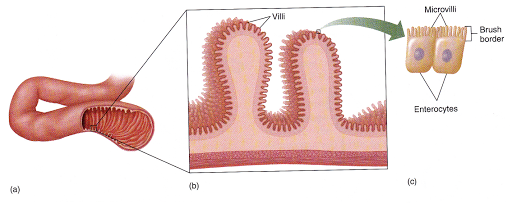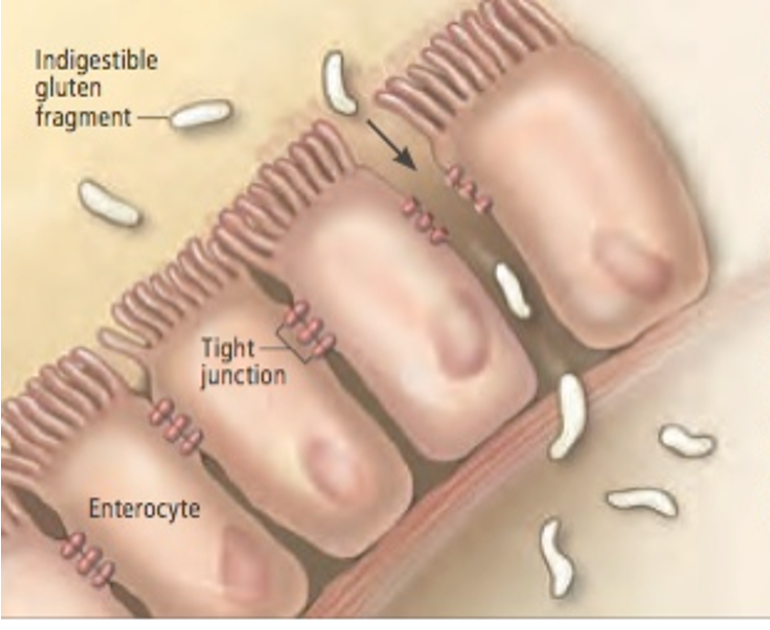Part 3 - The Small Intestine
Small Intestine
After your food leaves your stomach, it heads to the small intestine, which is where most of your food gets fully broken down and absorbed into your body. As you read in Part 2, digestive enzymes & bile mix with your food as soon as it leaves your stomach and starts the journey toward full digestion. The small intestine is an important place; it’s the spot for absorption and assimilation.
To make sure your food has space to be digested and absorbed, your small intestine has a giant surface area. If your small intestine were stretched out flat, it would be about the size of a small tennis court!
There’s a small but important ecosystem of bacteria living here. It’s only one cell layer thick, but it provides enormous protection for the epithelial layer in your small intestine (which, amazingly, is also only one cell layer thick). The epithelial layer is the top layer of your intestinal wall, where the digested food and nutrients in your digestive system move into your body and bloodstream.
This bacteria community also assists by producing extra enzymes to help you digest your food (like lactase to digest dairy). Your bacteria also help to heal your gut lining, and they communicate with your immune system to alert it if there’s a rogue invader, like a virus, trying to get through.
If you have undigested sugars in your small intestine, then you might feed bad bacteria and yeast (like candida). If this is happening, you also (usually) feel a lot of gas and bloating. This gas might blow up your intestine like a balloon and often is very visible (it can make you look pregnant).
If you have undigested protein in your small intestine and it “leaks” through a damaged spot in your epithelial layer, your immune system can be triggered. This issue is sometimes called a “leaky gut.” This immune reaction can trigger seasonal allergy symptoms, inflammation, and possibly autoimmune issues.
Undigested fat in the small intestine doesn’t cause too much trouble. It doesn’t trigger bloating or inflammation; it just slides on through. However, it can overlubricate your gut, which can trigger a fast and fatty bowel movement. If this happens to you, add some digestive bitters such as dandelion greens and ginger, to your routine to support your gall bladder and fat digestion.
This is what the inside of your small intestine looks like:
Symptoms of an imbalance in the small intestine:
Gas
Cramping
Visible bloating, especially to onions and garlic
abdominal pain
food sensitivities
lactose intolerance
slow metabolism
chronic inflammation
Seasonal allergies
Nutritional deficiencies
Brain fog
Eczema, psoriasis, or other skin rashes
Celiac disease
Leaky Gut
Leaky gut is a very common small intestinal condition and many of us have some leakiness in our gut without even knowing it.
Symptoms can include:
Food sensitivities & food allergies
Chronic inflammation
Seasonal allergies
Nutritional deficiencies
Brain fog
Eczema, psoriasis, or other skin rashes
Celiac disease
Auto-immune conditions may be connected to leaky gut as well, but more research is necessary.
A healthy small intestinal tract fully breaks down all of the food into single molecules and only allows these fully digested food particles through.
Leaky gut involves two breakdowns in the digestive system. First, protein doesn’t get digested properly, leaving undigested protein chains. Second, a weak spot in the small intestinal lining allows the undigested protein chain through the intestinal wall and into the bloodstream. This is where the immune system confuses it for a virus or bacteria (they look the same) and wages an attack. Only undigested protein triggers this reaction.
This up-regulated immune reaction can last up to 5 days. If you eat the offending food again within 5 days, then the immune system stays in attack mode. The up-regulated immune system is the cause of all of the symptoms of leaky gut, especially inflammation.
Fixing leaky gut involves fixing the two main problems – breaking food down and the “leaky” areas of the small intestine.
How to Heal Leaky Gut
The good news is this – your body will stop reacting to undigested food as long as one of the two breakdowns is resolved. We’re going to work on fixing both problems, but you’ll only react to a food if both breakdowns happen.
Food digestion –
Undigested carbs and fats will cause some problems in the small intestine, but with leaky gut the story is about protein. But, it should be noted that undigested carbs are the cause of major bloating and you might be dealing with that too.
To help your body digest all macronutrients, especially protein, it’s important to have good digestive habits (see Part 1). This will help to make sure your food can be digested once it reaches your small intestine.
A major reason we struggle to digest certain foods is because we eat them all the time and our pancreas runs out of steam and can’t keep up with enzyme production. By using digestive enzyme therapy, you can start to digest your food better while supporting your pancreas and helping it recover.
Enzyme Therapy
Look for a plant-based digestive enzyme because they work in a wide pH of 2 – 8, so they’ll work even if your stomach is weak.
In Canada & the US, Flora and Renew Life both carry great plant-based enzymes. Take 1 – 2 enzymes with each meal (take two if you’re eating a food that you struggle to digest). Aim to continue this protocol for 2 – 3 months. You may be able to stop the enzymes altogether or keep them on-hand to help you digest some more difficult food.
You can take most digestive enzymes for as long as needed. Don’t take enzymes that contain “ox bile” for longer than 6 months if you have a gall bladder (you can take them forever if you’ve had your gall bladder removed).
Healing your Intestinal Wall
Some foods can help to soothe your gut and reduce the symptoms that you’re feeling. You don’t need to use all of them. Just find one or two that help with the symptoms you’re feeling and make them a regular part of your diet.
Choose 1:
L-Glutamine powder (5g per day) –
Take every day with water. It’s a great gut healer and it’s not too expensive. You can also use it to heal sore in your mouth, just swish it in your mouth before you swallow.
Collagen (beef) (10g per day) –
Collagen is a very popular supplement and many people also take it for their skin and joints. Beef collagen (Type 3 collagen) is also a great gut healer. Mix 10g per day in water or throw in a smoothie.
Aloe Vera Juice (2 – 4 oz, 1 – 2x per day)
Taking aloe vera juice internally is like putting aloe gel on a burn on your skin. It’s cooling and soothing. It’s excellent for a tender esophagus that’s been damaged by acid reflux, and it’s also helpful for healing leaky gut. It can be helpful after radiation as well. Take 2 to 4 ounces, two times per day.
Ingesting aloe vera juice is not for anyone with latex or aloe allergies. If you’re in that group, a great alternative is 5 grams per day of L-glutamine powder.
Slippery Elm (1 tbsp, 1 – 3x per day)
This simple powder is like a soothing balm for your gut. It can heal any painful, irritated spots. It’s also a great regulator for your colon and helps with both constipation and diarrhea. It’s best for pain, cramping, and irregularity.
Take 1 teaspoon to 1 tablespoon in water, one to three times per day. Give the slippery elm one to three days to start working (although some people feel some relief almost immediately).
Got any questions or comments? Comment below, jump to our private Facebook Group, or the Ask Lisa page :).



